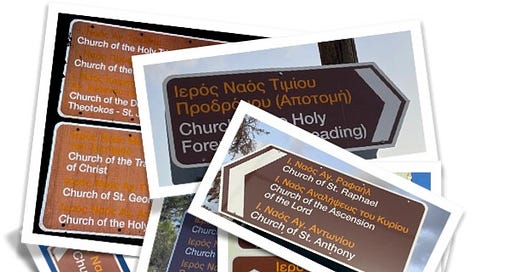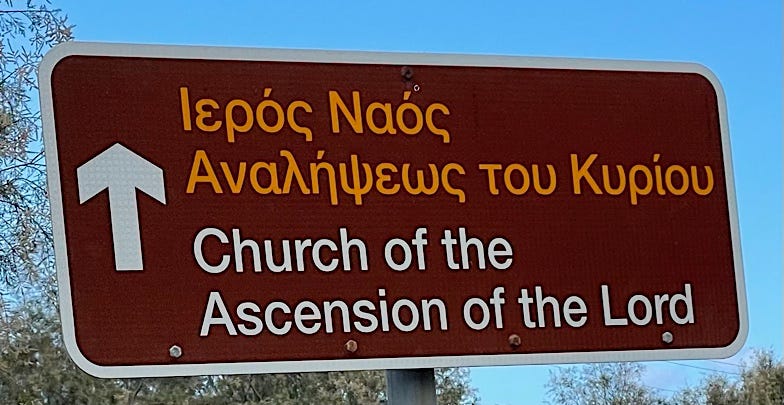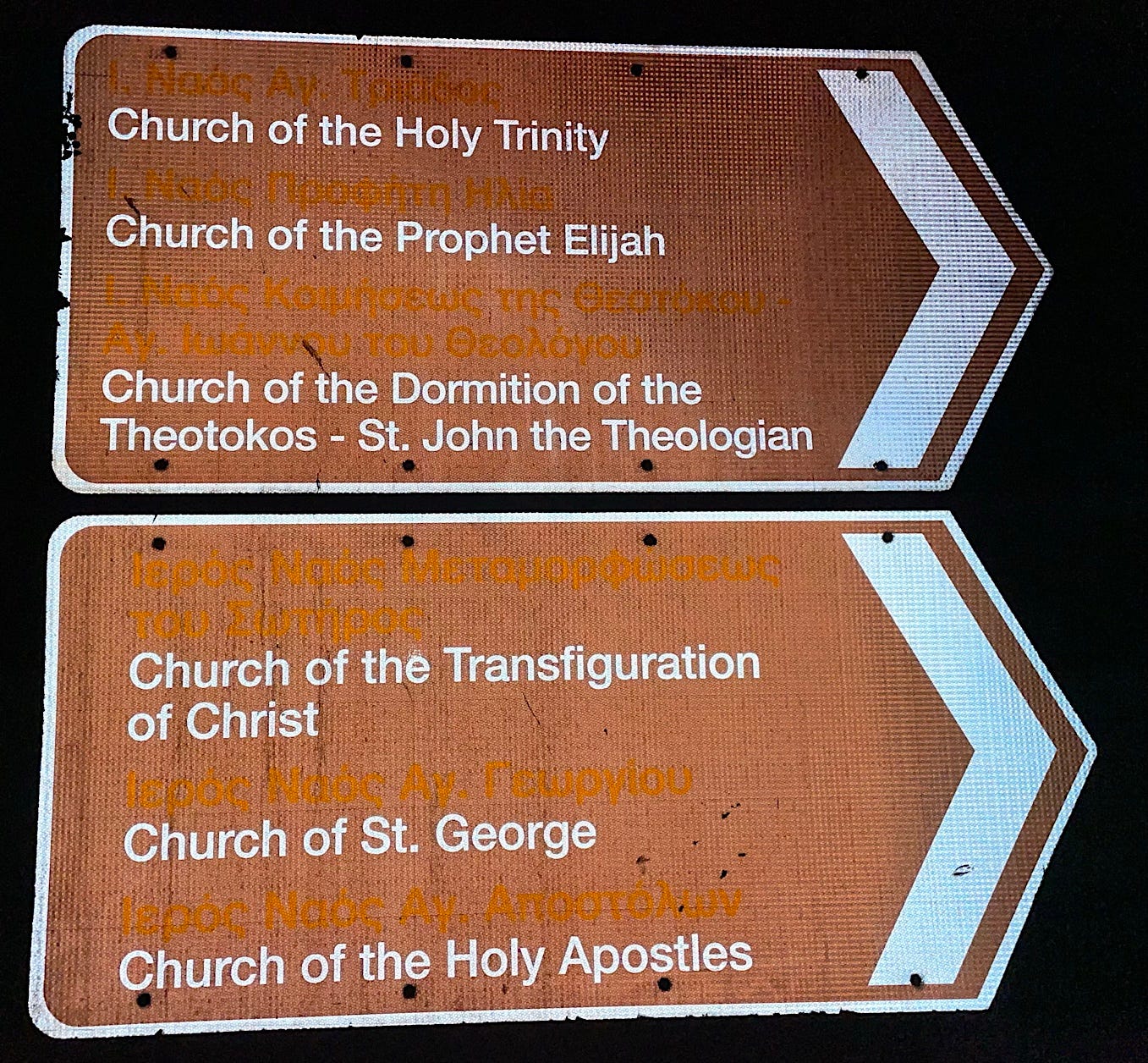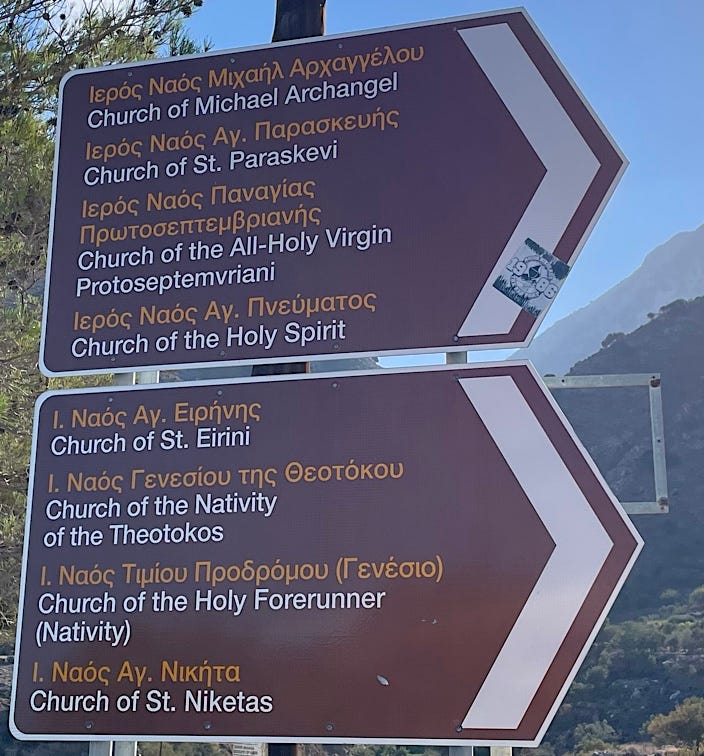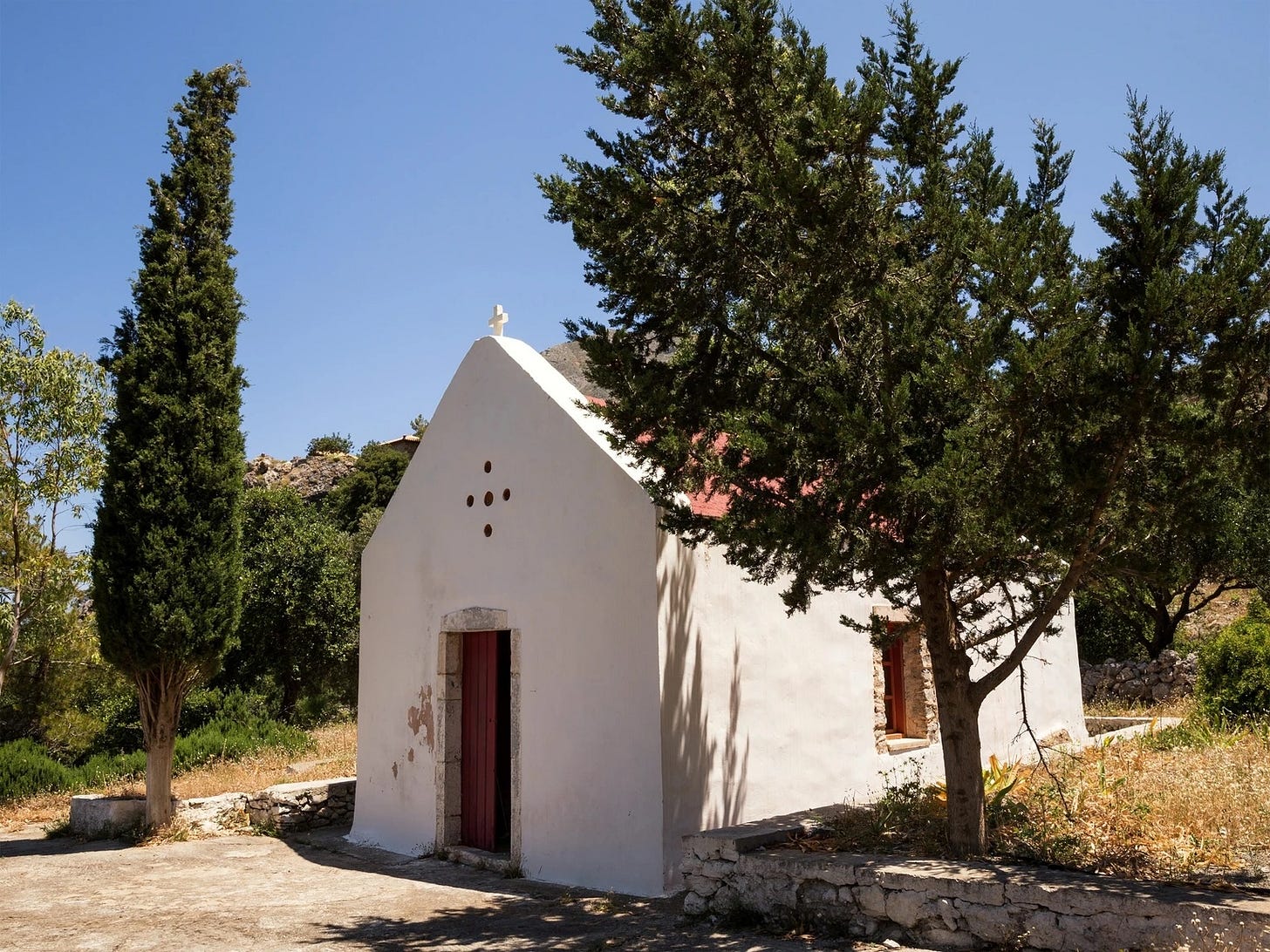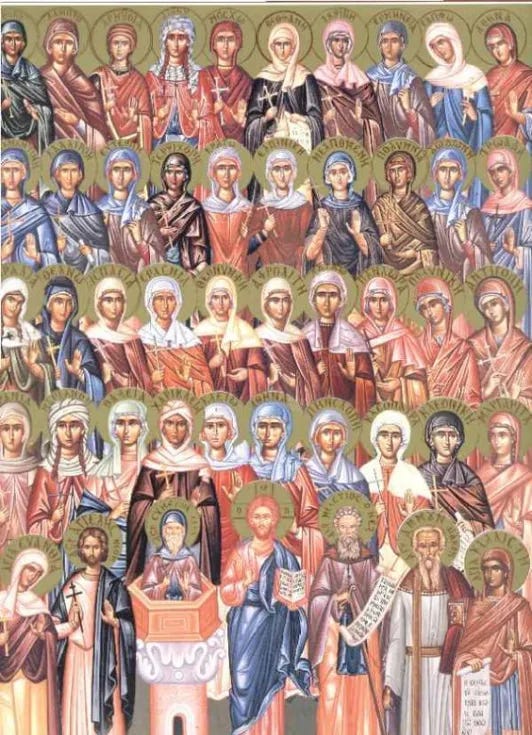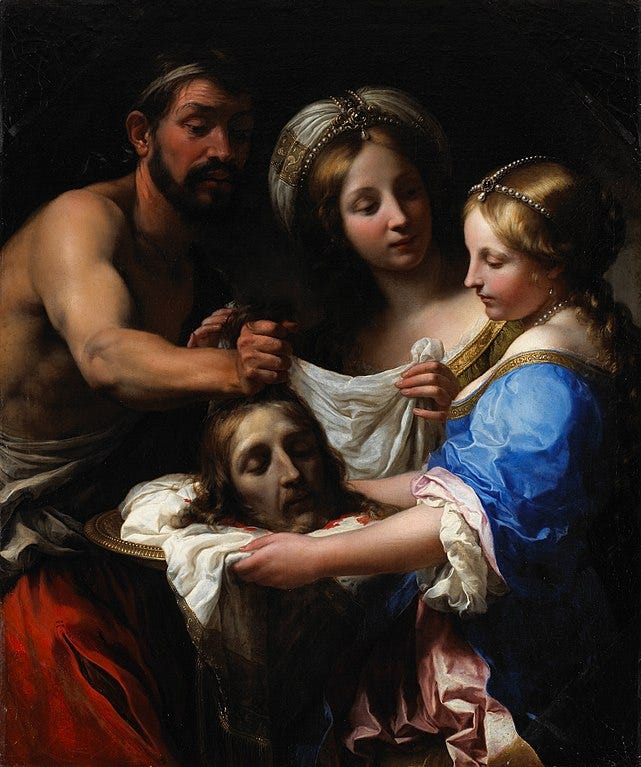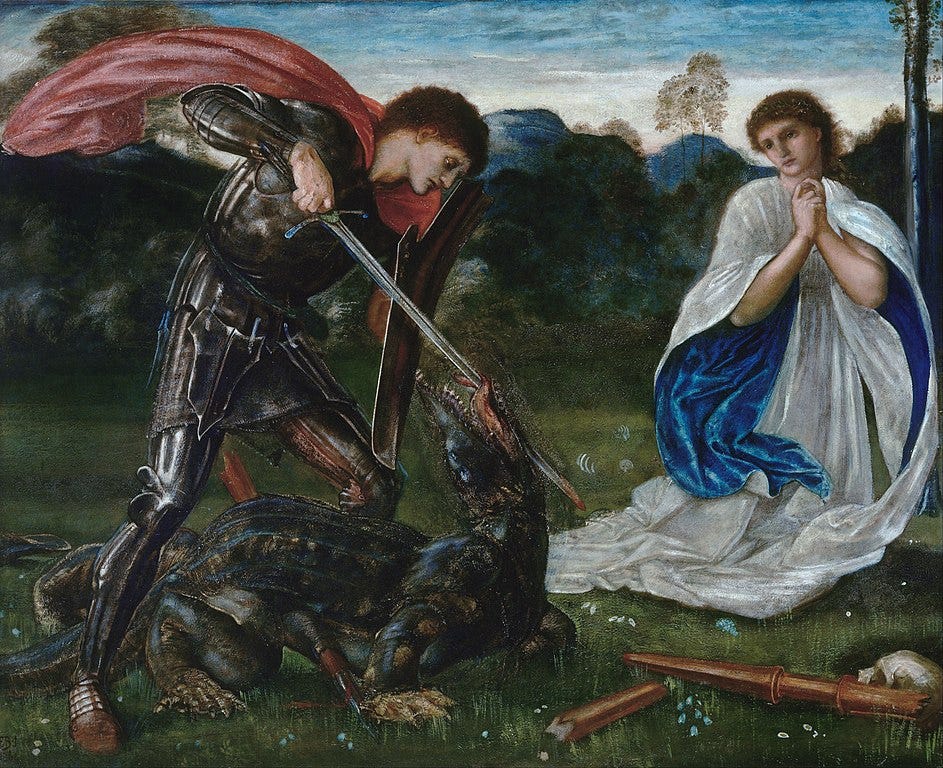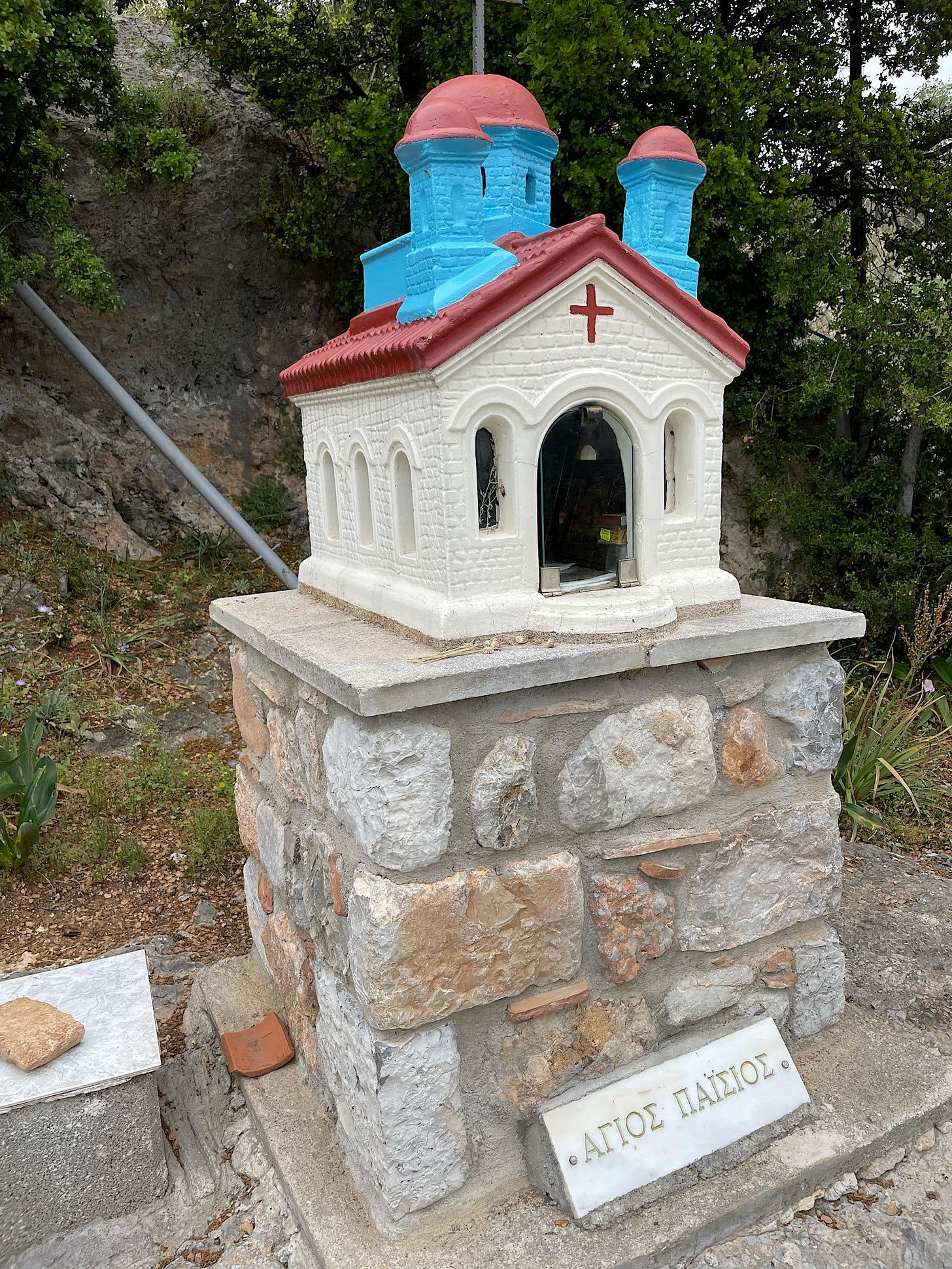This post is too long for email. Please click on the title to read it on the web!The Churches of Kavousi, Crete
Deisidaimonia in Small-Town Greece
So many churches!
I published a blog on the travels of the Apostle Paul as they intersected with our travels in Greece. In that posting, I told the story of how Paul, on his way into the city of Athens, was bothered by seeing all the “idols” along the side of the road. He used a version of the Greek word δεισιδαιμονία (deisidaimonia) which can mean, “god-fearing” or in a negative sense, “superstitious.”
I am by no means an expert on the theology of the Greek Orthodox Church. I am just impressed by the ubiquitous faith and piety we found everywhere in Greece. On a bus from downtown Thessaloniki to the airport, the teenage girl sitting near me (dressed for the club) crossed herself every time the bus passed a church.
And as Amy and I drove into the little town of Kavousi in the eastern Crete, I was struck–not bothered like Paul, but amazed and impressed—by the signs pointing to a multiplicity of churches in this tiny town.
In 2021, Kavousi boasted a population of 529 people, and I counted 20 churches within a 1-mile radius.
Up on the hils overlooking Kavousi. You can see the dome of Agia Triada.
We came to Kavousi for the second time in two years because Amy worked here on an archaological dig in 1990. We chose to spend the last of our eight weeks in Kavousi, hiking and taking road-trips around eastern Crete, which I have never seen. We got a luxurious AirB&B that came complete with some friendly cats.
Amy on our porch with cat.
Back to the churches. All are Christian churches, Greek Orthodox churches. Each is named after something prominent in Orthodox Christianity. Some of these eponyms were familiar to me (an Episcopalian) and Amy (a Roman Catholic). Some were not, and I had to look them up. Let’s go through the list, by category, and learn a little Greek and a little Church History in the process!
Churches Dedicated to Theological Concepts & Events
Ιερός Ναός (Ieros Naos)
Each church is a Ιερός Ναός (Ieros Naos), “Sacred Church”. The word νᾱός is an ancient word, going back to Homeric Greek: “Temple”, “shrine”. The Classical meaning seems always to a structure, whether permanent like the Parthenon in Athens or a small portable shrine. Later it seems more appropriate to translate the word as “church”, since it can refer to the building or the congregation of people who come together to worship. Paul plays with this double-meaning—“church” as building and “church” as congragation. In the First Letter to the Corinthians, 3.16, he says to his followers, “Don’t you know that you are a church of God, and the Spirit of God dwells in you!” (Οὐκ οἴδατε ὅτι ναὸς θεοῦ ἐστὲ καὶ τὸ πνεῦμα τοῦ θεοῦ ἐν ὑμῖν οἰκεῖ;).
Alas, the Greek letters on this sign were invisible to nighttime flash photography.
Kavousi boasts four churches dedicated to the Divinity, one way or another.
There is a Church of the Holy Trinity (Naós Hagías Triádos, Naos Hagias Triados), dedicated to the “Father, Son, and Holy Spirit”. This is the main church at the center of town. Almost every town we visited had a Naos Hagias Triados.
A very small picture of Agia Triada at the center of Kavousi.
There is a church dedicated specifically to the Holy Spirit (Naós Αγίου Πνεύματος, Naos Hagiou Pneumatos), representing the “Third Person of the Trinity” (after the Father and Son). It is up a little road, above the city.
Amy and Yiannis lighting candles and burning incense to bless their families. The rule against bare shoulders is relaxed in the more remote and un-staffed churches.
Most of these churches are not normally staffed with priests. Their doors stand open so the faithful can enter, pray, and perhaps light a candle and burn incense. On the religious holidays associated with a church’s namesake the local people will come with the priest for a special service. This Church of the Holy Spirit will be the site of a special service on “Holy Spirit Monday”, which is a Greek Orthodox holiday marking the end of the season of Easter.
Holy Spirit Monday is the day after Pentecost, a holiday falls on the the fiftieth day after Easter (Greek πεντηκοστή [ἡμέρα], pentēkostē hēmera, means “fiftieth day”). In the Book of Acts, this is the day that the Holy Spirit came down and landed on the Apostles. This marked the moment that the whole Trinity was together, Father, Son, and Holy Spirit. The Holy Spirit enabled the Apostles (temporarily) to speak in many foreign languages and thus to preach to the diverse community of Jews in Jerusalem. This is described in Acts 2.1-2.31.
The Book of Acts is not without humor. With all of the Apostles suddenly speaking strange languages, Peter was obliged to assure the people of Jerusalem that, “It isn’t the case that they are drunk, as you suppose—it is only 9:00 AM after all!” (οὐ γὰρ ὡς ὑμεῖς ὑπολαμβάνετε οὗτοι μεθύουσιν, ἔστιν γὰρ ὥρα τρίτη τῆς ἡμέρας.) (Acts 2.15).
There is a Church of the Ascension of the Lord (Ιερός Ναός Αναλήψεως του Κυρίου, Ieros Naos Analēpseōs tou Kuriou). Ἀνάληψις (analēpsis), from ἀνά (“up”) and λαμβάνω, (“I take”), refers to the moment when Jesus, who had risen from the dead and spent a while with his disciples, went up to heaven. The Bible offers different versions of these events, but our Naós Hagías in Kavousi is dedicated to the Feast of the Ascension, on the 40th day after Easter, ten days before Pentecost.
The Ascension on the Drogo Sacramentary, c. AD 850
The last church dedicated to some aspect of the Trinity is the Church of the Transfiguration [of the Savior] (Ιερός Ναός Μεταμορφώσεως του Σωτήρος, Ieros Naos Metamorphōseōs Sōtēros).
They can abbreviate “Ιερός Ναός” to “Ι. Ναός,” but won’t if they don’t have to. Note that they English has “Christ” where the Greek has “Savior”.
The Transfiguration—in Greek, literally, “metamorphosis”—was an event in the life of Jesus when he led his followers to a mountain, ascended the mountain, began to shine with divine glory, and is joined by Moses and Elijah. Wikipedia has citations to biblical texts and a good discussion of the theology.
Raphael painted the Transfiguration
The Feast of the Transfiguration is celebrated in August, either the 6th or the 19th depending on which calendar (Julian, Revised Julian, or Gregorian) is used.
I am no theologian, but it seems to me that the Transfiguration (Jesus goes up a mountain and reaches the regions of the divine) and Pentecost (the disciples suddenly speak many foreign languages) might “complete” the story of the Tower of Babel in Genesis 11.1–11.9, where humans try to build a tower to heaven, and are thwarted when God divides the workforce into different and mutually incomprehensible language-groups. (Genesis doesn’t say “Babel”, just “a city and tower”, πόλιν καὶ πύργον).
Kavousi has a Church of Agia Eirini, Αγία Ειρήνη, which is the “Holy Peace”. Εἰρήνη is one of a kind of “trinity” of attributes of, or blessing from, God. The Roman Emperors set up shrines to these three in Constantinople: Holy Peace (Εἰρήνη), Holy Power (Δύναμις), and of course the most famous, the Hagia Sophia, Holy Wisdom (Σοφία).
Solomon with a personification of Agia Eirini, “Lady Wisdom”
Churches Dedicated to Mary
After the Trinity, of course, is the Virgin Mary, and she has three churches near Kavousi, each dedicated to a specific Feast Day.
Among many, two of these point to Churches of Mary
Mary, in the Greek Orthodox faith, has many epithets, but most commonly she is the Theotokos (Θεοτόκος) “The One who Bore God”, or the Mētēr tou Theou (Μήτηρ τοῦ Θεοῦ), the “Mother of God”, or the Panagios(Πανάγιος), the “All-Holy”.
A modern icon naming Mary “ΜΡ ΤΥ”, the usual abbreviation for “Μήτηρ τοῦ Θεοῦ” on icons.
One church in Kavousi is the Church of the Nativity of the Theotokos (Ιερός Ναός Γενεσίου της Θεοτόκου, Ieros Naos Genesiou tēs Theotokou), that is, Mary’s birthday. This event is not mentioned in the Bible, but the Feast celebrating it is held on September 8.
Mary’s birthday is the first of the events in Mary’s life, according to the traditions of the Orthodox church. The last event in her earthly life also has its own church in Kavousi, the Church of the Dormition of the Theotokos (Ναός της Κοιμήσεως της Θεοτόκου, Naos tēs Koimēseōs tēs Theotokou).
Because I did not grow up in the Catholic or Orthodox church, I had never heard of this “Dormition” until the second time I came to Greece, in 2001. Maybe everyone else knows all about it, but just in case… Mary’s “Dormition” is a Latinized version of κοίμησις (koimēsis) when she “went to sleep”. Mary did not die, according to Tradition, but simply went to sleep.
The writing says, ἡ κοίμησις (left) and ΤΗΣ θΚΟΥ, an abbreviation of “της Θεοτόκου”
The Dormition is tied up with the Immaculate Conception, another concept this Episcopalian didn’t understand until he was a 33-year-old Professor. I’d assumed it referred to the conception of Christ, but I was wrong. The Immaculate Conception refers to the conception and birth of Mary. She had to be completely free from Original Sin in order to serve as the Theotokos, so she was conceived through a mysterious asexual process. Because she was completely sinless, she was immune to death. Evidently this, one of the “Marian dogmas”, is very controversial among all branches of Christianity..
Mary has a third church in Kavousi, the amazingly named Church of the All-Holy Virgin Protoseptemvriani (Ιερός Ναός Παναγίας Πρωτοσεπτεμβριανίς, Ieros Naos Panagias Prōtoseptembrianis). It has its own web-page.
A lovely little church on the slopes behind Kavousi
I definitely had to look this one up. “All-holy”, Πανάγιος, is easy enough. And I could parse Πρωτοσεπτεμβριανίς into “First of September”, after “prōto-” and Σεπτέμβριος but I didn’t know that September 1 is the Festival of the Indictus, the first day of the Greek Orthodox Ecclesiastical Year. The Church’s New Year was once September 23rd, coinciding with some calculation of the Autumnal Equinox, but since that date was also the birthday of the Roman Emperor Octavian/Augustus, the religious festival was moved to the 1st. So this lovely little Church celebrates “The All-Holy Virgin of the First of September.”
September 1 is also the Feast of the 40 Virgin Martyrs and their Teacher the Deacon Ammon.
The 40 Virgin Martyrs of Heracleia
These forty young women and their teacher were arrested in the 4th Century and condemned by Licinius, the Roman emperor who was Constantine’s great rival. They suffered martydom in various horrible ways. The Church honors them on New Year’s Day, and faithfully records their names: Holy Martyr Ammon the Deacon, as well as Adamantine, Athena, Akrive, Antigone, Arivea, Aspasia, Aphrodite, Dione, Dodone, Elpinike, Erasmia, Erato, Ermeneia, Evterpe, Thaleia, Theanoe, Theano, Theonymphe, Theophane, Kalliroe, Kalliste, Kleio, Kleonike, Kleopatra, Koralia, Lambro, Margarita, Marianthe, Melpomene, Moscho, Ourania, Pandora, Penelope, Polymnia, Polynike, Sapfo, Terpsichore, Troada, Haido, and Harikleia.
Students who may stumble upon this blog: You owe it to yourselves to read through that list of names. I count the names of seven of the nine Muses, of a number of (pagan) Greek goddesses, and a number of figures from Classical Greek literature. There is a term-paper topic in here somewhere… you’re welcome!
Churches Dedicated to Other Divine Figures
There is a Church of Michael the Archangel (Ιερός Ναός Μιχαήλ Αρχαγγέλου, Ieros Naos Michaēl Archangelou). Michael is a figure in Judaism, Christianity, Islam, and Bahá’í. He is sometimes called in the Orthodox Church “The Taxiarch”, from ταξίαρχος, “Commander of a Military Corps” or “Brigadier”. He shows up in the Revelation of St. John (12.7–12.12) doing battle with Satan in the form of a dragon.
Michael defeating the dragon, in Hamburg.
The Church of St. Raphael is dedicated to another named Angel. Raphael first appears in the apocryphal Book of Tobit and is the Angelic Being associated with healing.
There is a Church of the Prophet Elijah (Ναός Προφήτη Ηλία, Naos Profētē Ēlia). The Prophet Elijahappears in many places in the Hebrew Bible; he is a revered figure in Judaism, Christianity, Islam, and Bahá’í.
If you navigate Greece using a topographical map, you may come to the conclusion that every third mountain is called “Profitis Ilias”. This was confusing to me at first, given my background, because “Ilias”, Ἰλιάς, is the Greek for the Homeric Iliad. But of course the name in Greek is Προφήτης Ηλίας, “Prophet Elias”, transliterated according to the modern convention that turns eta into “i”… so, “Profitis Ilias”. Legend and tradition associate Elijah with mountains—one story says that he had been a sailor and almost drowned in a shipwreck; ever after he tried to stay as far from the sea as possible.
One of many instances of Profitis Ilias, up above Sparta
The mountains themselves are not “Profitis Ilias”, but there are hundreds and hundreds of little Profitis Ilias churches on the mountains of Greece, and these appear on our maps. We hiked up to a few of them during our travels.
We hiked up to a Profitis Ilias on Rhodes.
Churches Dedicated to Saints
Two of the most important saints to the Greeks are John and George. There are three churches in Kavousi named after a Saint John, but these represent two different Johns. There are two churches dedicated to John the Baptist, whom the Greeks call Agios Ioannis Prodromos, Άγιος Ιωάννης ο Πρόδρομος. Prodromos is from πρόδρομος, the “Forerunner” or “Precursor”, since John came first to announce the Christ.
As with Mary, the two churches to John the Prodromos are dedicated to specific events in his life. There is a Church of the Nativity of the Prodromos, dedicated to his birth, which is called the Ιερός Ναός Τιμίου Πρόδρομου (Γενέσιο), literally, “The Holy Church of the Honored Forerunner (Birth)”. For this church, John is identified by another of his epithets, Τίμιος. This epithet is pretty common for John. The story of the birth of John is at Luke 7.1-7.15.
This sign caught my eye as we entered town.
There is also the startling Church of the Holy Forerunner (Beheading), Ιερός Ναός Τιμίου Πρόδρομου (Αποτομή). The story of the death of John is at Mark 6.14-6.28. Mark uses the verb ἀποκεφαλίζω for “beheading.”
A painting by Onorio Marinari from the 1670s
There is also a Church of Saint John the Theologian (Ιερός Ναός Ιωάννης Θεολόγου). This church is dedicated to John the Apostle, traditionally identified as the author of the Gospel of John, Revelation, and the “Johannine Epistles”. All of these identifications are super controversial.
John the Theologian in a 13th Century Armenian manuscript
The Church of Saint George is dedicated to the most imporant Saint, to the Greeks, after John the Forerunner. The big Greek Orthodox cathedral in Greenville, SC, is St. George. George is Γεωργός in Greek (the word means “farmer”). Georgos and its feminine equivalent Georgia are really common names in Greece and among Greek Americans.
St. George was a Roman soldier under Emperor Diocletian who was martyred for refusing to give up his Christian faith. The Wikipedia article has a fun section on Edward Gibbon’s theories about George and how everyone else thinks Gibbon is wrong—stuff about taxes and Athenasius, which you can read for yourselves. The romantic stories of George involve him fighting a dragon who was about to eat a princess named Sabra.
George kills the dragon as the lovely Sabra looks upon her hero.
Those are the big-name Saints. There are others. Kavousi has a Church of St. Niketas, dedicated to Niketas the Goth who lived during the reign of Constantine but was martyred by order of a judge among the Visigothic tribes.
It has a Church of St. Fotini. Fotini (Φωτεινή) , or Photine, is The Shining One. According to tradition, she is the Samaritan Women whom Jesus meets at a well in John 4.4–4.26. Tradition says, further, that after this encounter she became an evangelist, defied the Emperor Nero and died a martyr’s death with her sisters.
Note to self for another blog post or video: Some of the tortures Nero devised for Photini and her sisters resemble things in the Theseus myth.
We did not visit the Church of St. Paraskevi. Παρασκευή can refer to a number of Saints. The word means “preparation”, and because it was used in Scripture for “the Day of Preparation before the Sabbath”, it came to mean “Friday”. The personification of Friday is venerated in the Greek Church, as is the Saint known as Paraskevi of the Balkans. I would like to think that this Paraskevi is the woman identified by Tradition as the sister of Fotini, the Samaritan woman at the well. But it is most likely that this is the Church of Paraskevi of Rome.
And lest no one get left out, there is a Church of the Holy Apostles, Ιερός Ναός Αγίων Αποστόλων (Ieros Naos Agiōn Apostolōn). Note, Greek students, the obvious genitive plural!
The inclusive Church of the Holy Apostles
Deisidaimonia in Kavousi
So the village of Kavousi is inarguably deisidaimōn (δεισιδαίμων), God-fearing and devoted both to Biblical texts and to 2,000 years of Tradition. There is a lot that I don’t understand. How did each of these churches come to be founded? Who chose the particular objects of veneration for each? Why “Birthday” and “Beheading” for St. John, for example, or “Birth” and “Dormition” for Mary (as opposed to Annunciation and Nativity)?
All of small-town Greece is like Kavousi in this respect, as far as we could tell. And this (very long… sorry!) blog post didn’t even touch the dozens and dozens of tiny shrines that you see along the roads and along even the most remote trails. Each of these is a naos (νᾱός), like the ones Herodotus describes in Egypt: “The image of the god, in a little gilded wooden shrine…” (τὸ δὲ ἄγαλμα ἐὸν ἐν νηῷ μικρῷ ξυλίνῳ κατακεχρυσωμένῳ) (Hdt. 2.63.2).
A tiny shrine for Saint Païsios, on a trail south of Delphi.
If you want a truly relaxing vacation in Greece, skip Athens with its crowds and tourist-trap tavernas and costly tickets. Find a little village, anywhere, and spend a week visiting all the little churches. If you go to Kavousi, you can grab a midday drink and snack at the elegant Café Chez George and enjoy dinner in the evening at Ntakos, to which you should bring a big appetite.
Kavousi’s biggest tourist attraction, however, the only one on TripAdvisor, pre-dates Christianity by at least a thousand years. I’ll write about that in a separate post.
The mountains behind Kavousi.

